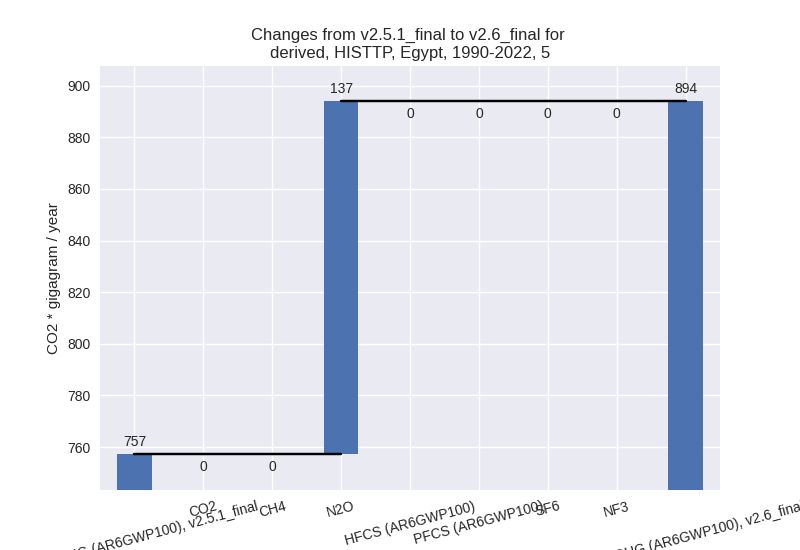Changes in PRIMAP-hist v2.6_final compared to v2.5.1_final for Egypt
2024-09-24
Johannes Gütschow
Change analysis for Egypt for PRIMAP-hist v2.6_final compared to v2.5.1_final
Overview over emissions by sector and gas
The following figures show the aggregate national total emissions excluding LULUCF AR6GWP100 for the country reported priority scenario. The dotted linesshow the v2.5.1_final data.
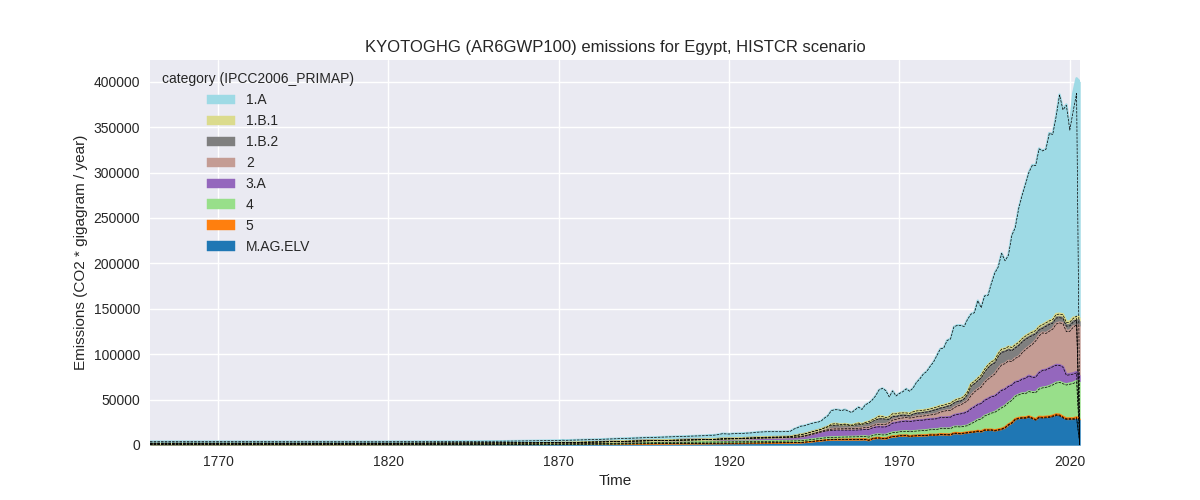
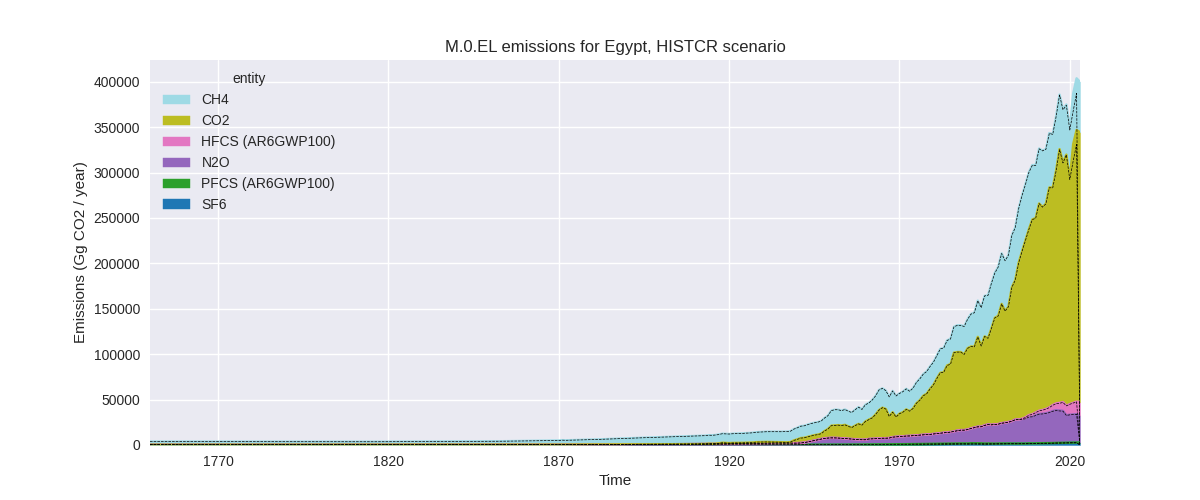
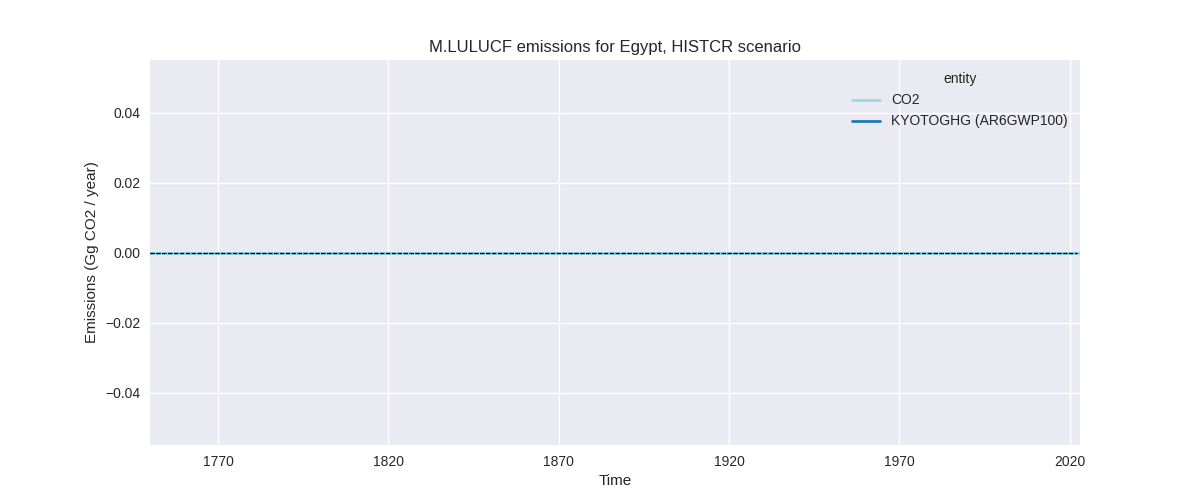
The following figures show the aggregate national total emissions excluding LULUCF AR6GWP100 for the third party priority scenario. The dotted linesshow the v2.5.1_final data.

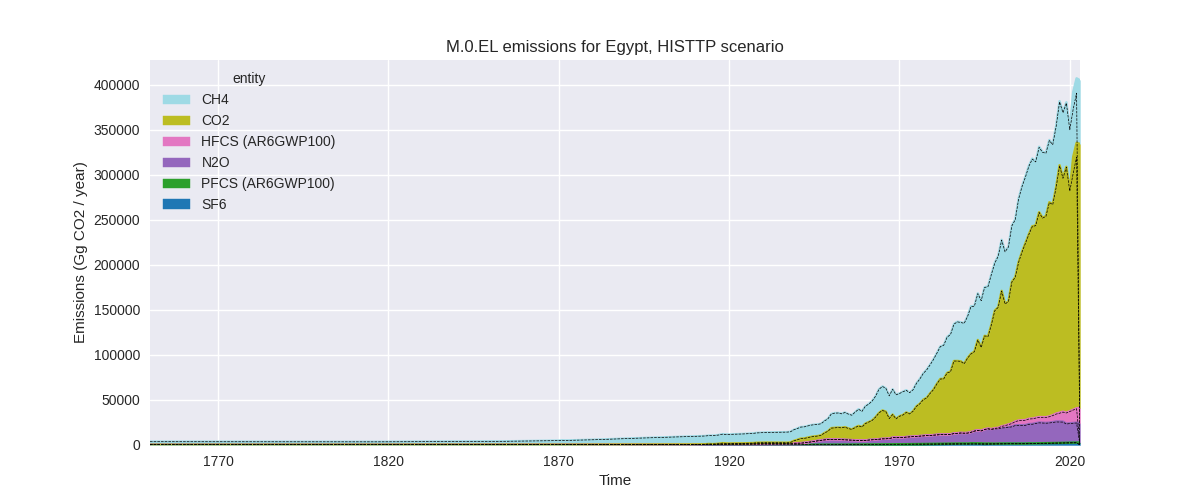
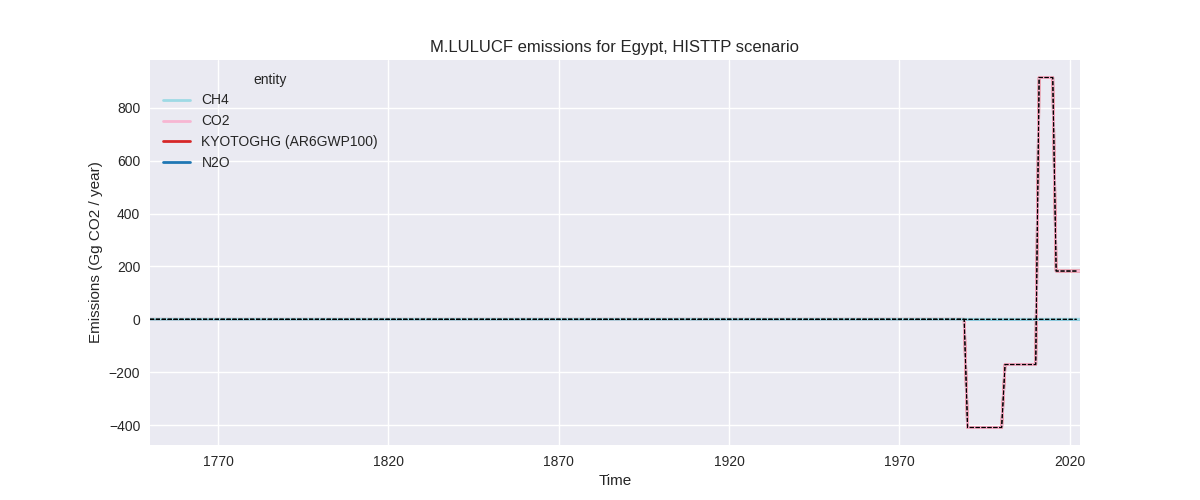
Overview over changes
In the country reported priority scenario we have the following changes for aggregate Kyoto GHG and national total emissions excluding LULUCF (M.0.EL):
- Emissions in 2022 have changed by 4.3%% (16644.34 Gg CO2 / year)
- Emissions in 1990-2022 have changed by 0.5%% (1313.41 Gg CO2 / year)
In the third party priority scenario we have the following changes for aggregate Kyoto GHG and national total emissions excluding LULUCF (M.0.EL):
- Emissions in 2022 have changed by 4.2%% (16536.83 Gg CO2 / year)
- Emissions in 1990-2022 have changed by 0.6%% (1574.28 Gg CO2 / year)
Most important changes per scenario and time frame
In the country reported priority scenario the following sector-gas combinations have the highest absolute impact on national total KyotoGHG (AR6GWP100) emissions in 2022 (top 5):
- 1: 1.A, CO2 with 17621.66 Gg CO2 / year (7.2%)
- 2: 2, CO2 with -2050.32 Gg CO2 / year (-6.3%)
- 3: 4, CH4 with 689.58 Gg CO2 / year (1.8%)
- 4: 5, N2O with 201.29 Gg CO2 / year (16.1%)
- 5: 2, HFCS (AR6GWP100) with 87.37 Gg CO2 / year (0.6%)
In the country reported priority scenario the following sector-gas combinations have the highest absolute impact on national total KyotoGHG (AR6GWP100) emissions in 1990-2022 (top 5):
- 1: 1.A, CO2 with 1087.49 Gg CO2 / year (0.7%)
- 2: 5, N2O with 136.67 Gg CO2 / year (18.0%)
- 3: 4, CH4 with 96.05 Gg CO2 / year (0.4%)
- 4: 2, CO2 with -62.13 Gg CO2 / year (-0.3%)
- 5: 1.B.2, CO2 with 5.47 Gg CO2 / year (0.2%)
In the third party priority scenario the following sector-gas combinations have the highest absolute impact on national total KyotoGHG (AR6GWP100) emissions in 2022 (top 5):
- 1: 1.A, CO2 with 17193.49 Gg CO2 / year (7.2%)
- 2: 2, CO2 with -2020.00 Gg CO2 / year (-5.9%)
- 3: 4, CH4 with 680.94 Gg CO2 / year (3.2%)
- 4: 2, HFCS (AR6GWP100) with 230.36 Gg CO2 / year (1.5%)
- 5: 5, N2O with 201.29 Gg CO2 / year (16.1%)
In the third party priority scenario the following sector-gas combinations have the highest absolute impact on national total KyotoGHG (AR6GWP100) emissions in 1990-2022 (top 5):
- 1: 1.A, CO2 with 1061.07 Gg CO2 / year (0.7%)
- 2: 4, CH4 with 257.08 Gg CO2 / year (1.6%)
- 3: 5, N2O with 136.67 Gg CO2 / year (18.0%)
- 4: 4, N2O with 134.59 Gg CO2 / year (10.2%)
- 5: 2, CO2 with -61.21 Gg CO2 / year (-0.3%)
Notes on data changes
Here we list notes explaining important emissions changes for the country. ’' means that the following text only applies to the TP time series, while means that it only applies to the CR scenario. Otherwise the note applies to both scenarios.
- There are no new country reported emissions for Egypt.
- EI emissions estimates for energy CO2 are higher after 2020.
- Cement CO2 emissions are lower in the latest release of the Andrew cement dataset.
- The impact on cumulative emissions is small.
- Changes in sectors 4 and 5 are due to the removal of FAOSTAT data.
- Changes in the third part time series are similar to changes in the CR timeseries.
Changes by sector and gas
For each scenario and time frame the changes are displayed for all individual sectors and all individual gases. In the sector plot we use aggregate Kyoto GHGs in AR6GWP100. In the gas plot we usenational total emissions without LULUCF. ## country reported scenario
2022
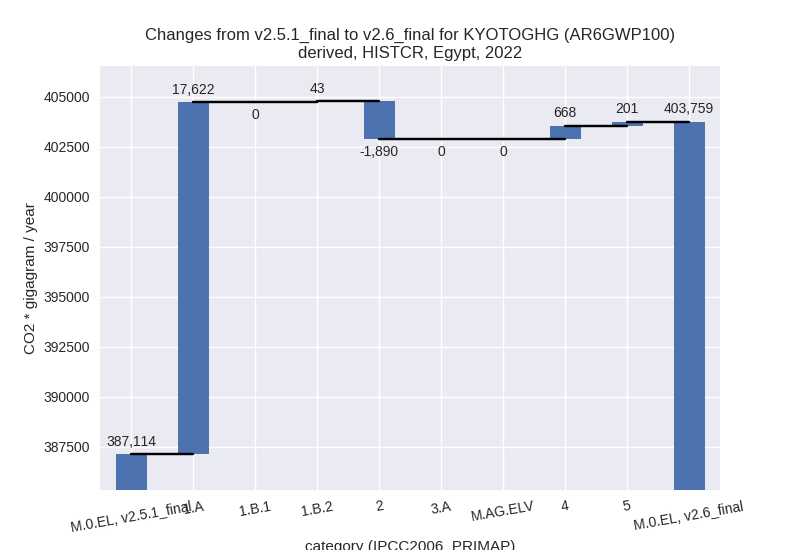

1990-2022
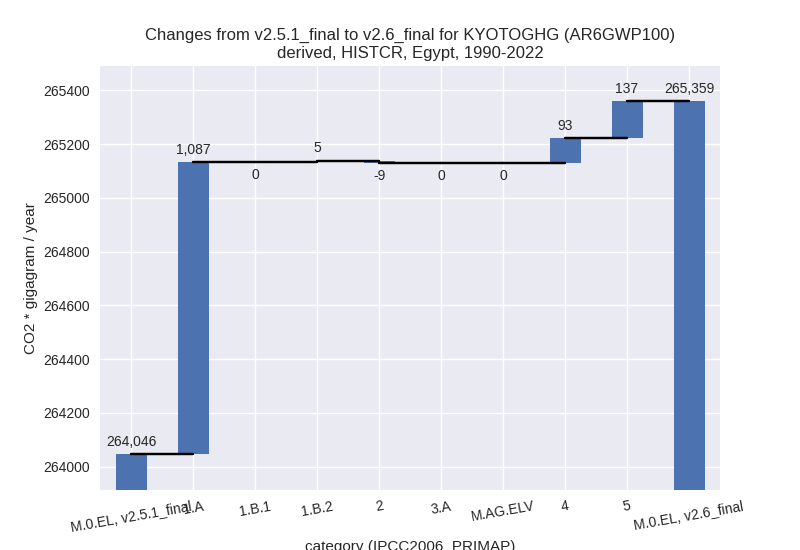
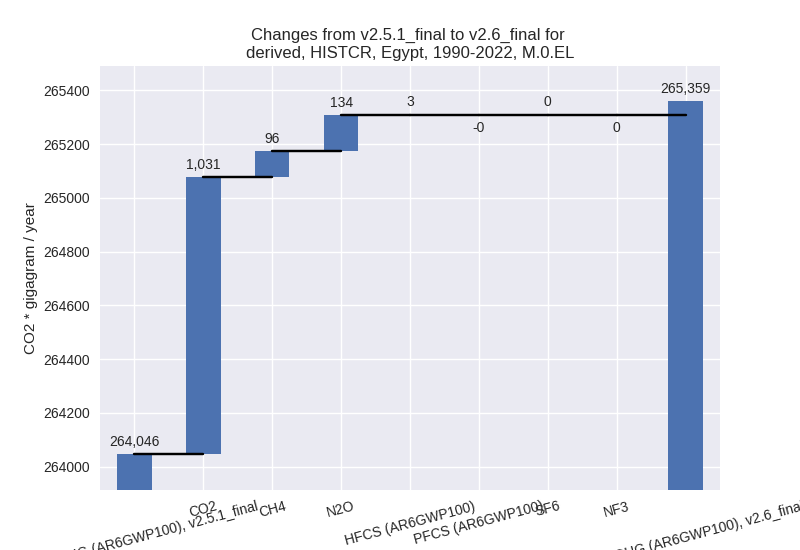
third party scenario
2022

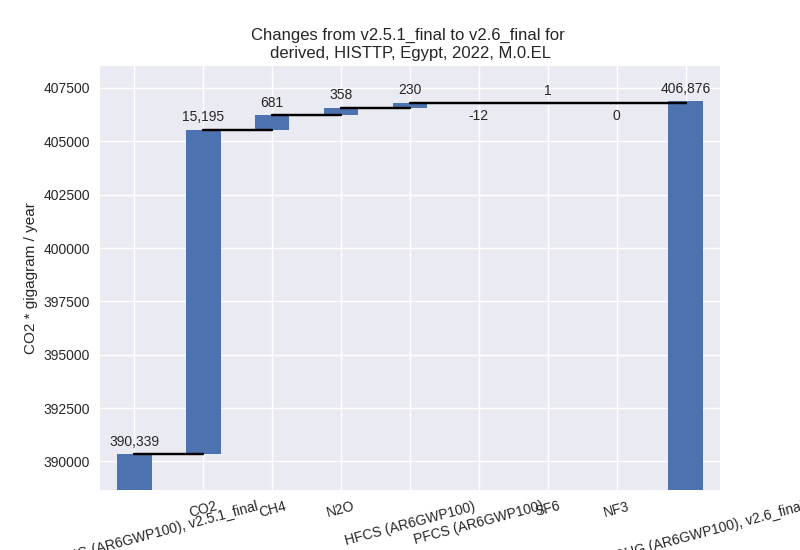
1990-2022
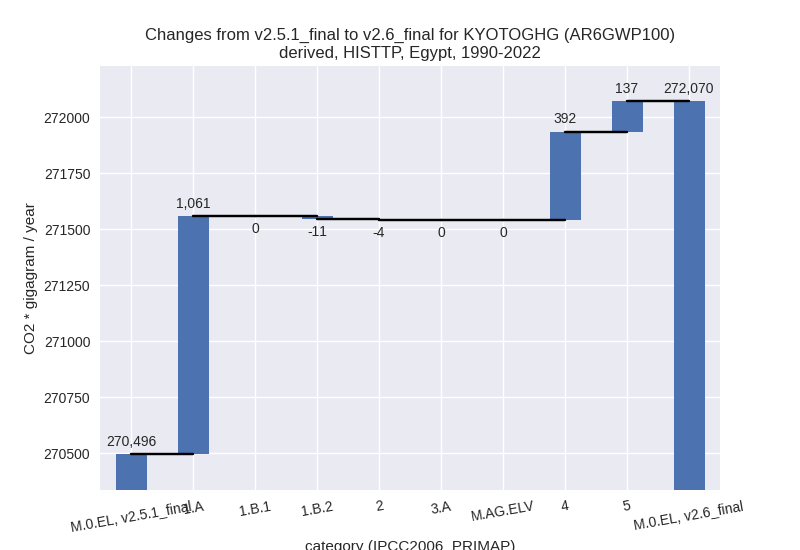
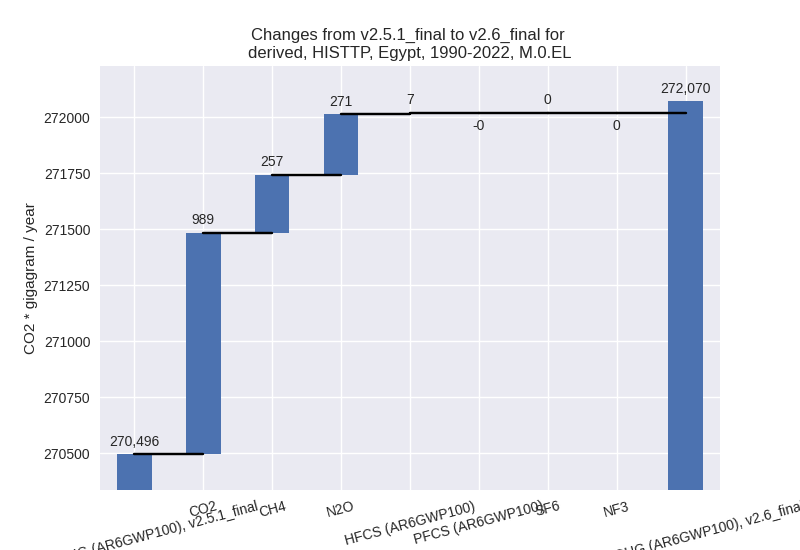
Detailed changes for the scenarios:
country reported scenario (HISTCR):
Most important changes per time frame
For 2022 the following sector-gas combinations have the highest absolute impact on national total KyotoGHG (AR6GWP100) emissions in 2022 (top 5):
- 1: 1.A, CO2 with 17621.66 Gg CO2 / year (7.2%)
- 2: 2, CO2 with -2050.32 Gg CO2 / year (-6.3%)
- 3: 4, CH4 with 689.58 Gg CO2 / year (1.8%)
- 4: 5, N2O with 201.29 Gg CO2 / year (16.1%)
- 5: 2, HFCS (AR6GWP100) with 87.37 Gg CO2 / year (0.6%)
For 1990-2022 the following sector-gas combinations have the highest absolute impact on national total KyotoGHG (AR6GWP100) emissions in 1990-2022 (top 5):
- 1: 1.A, CO2 with 1087.49 Gg CO2 / year (0.7%)
- 2: 5, N2O with 136.67 Gg CO2 / year (18.0%)
- 3: 4, CH4 with 96.05 Gg CO2 / year (0.4%)
- 4: 2, CO2 with -62.13 Gg CO2 / year (-0.3%)
- 5: 1.B.2, CO2 with 5.47 Gg CO2 / year (0.2%)
Changes in the main sectors for aggregate KyotoGHG (AR6GWP100) are
- 1: Total sectoral emissions in 2022 are 272219.21
Gg CO2 / year which is 67.4% of M.0.EL emissions. 2022 Emissions have
changed by 6.9% (17664.45 Gg CO2 /
year). 1990-2022 Emissions have changed by 0.7% (1092.97 Gg CO2 / year). For 2022 the
changes per gas
are:
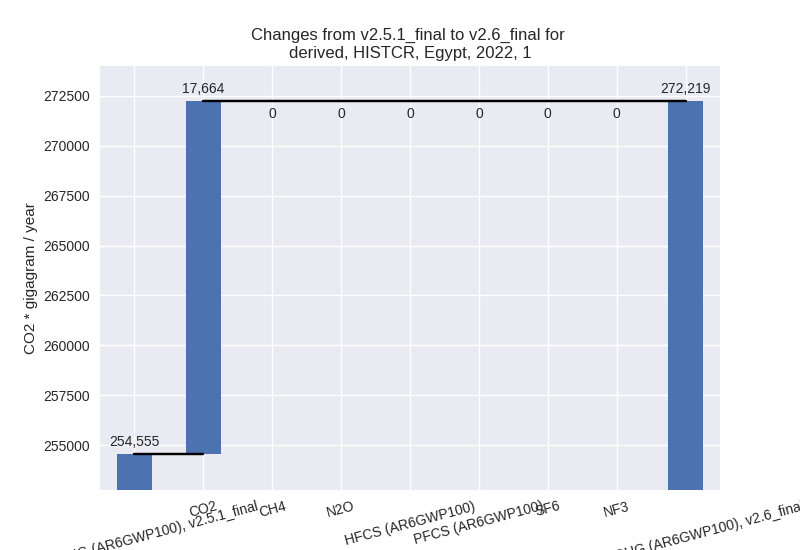
The changes come from the following subsectors:- 1.A: Total sectoral emissions in 2022 are 262786.55
Gg CO2 / year which is 96.5% of category 1 emissions. 2022 Emissions
have changed by 7.2% (17621.67 Gg
CO2 / year). 1990-2022 Emissions have changed by 0.7% (1087.49 Gg CO2 / year). For 2022 the
changes per gas
are:
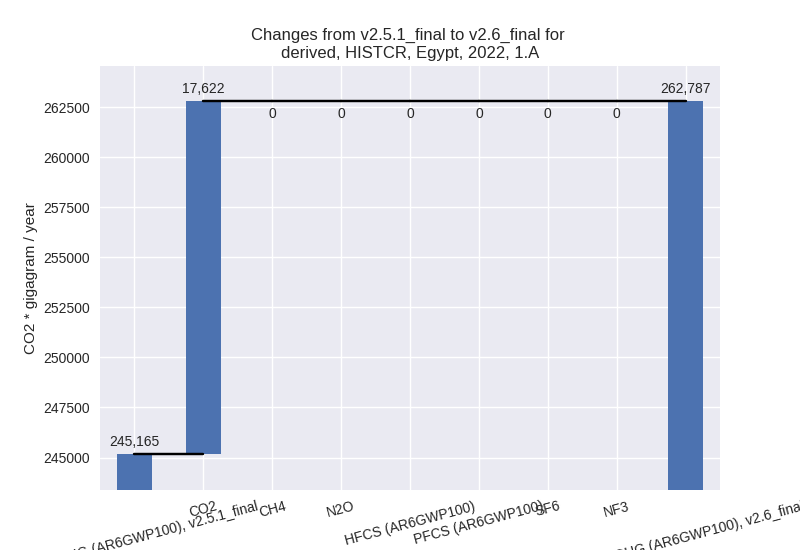
There is no subsector information available in PRIMAP-hist. - 1.B.1: Total sectoral emissions in 2022 are 4019.48 Gg CO2 / year which is 1.5% of category 1 emissions. 2022 Emissions have changed by 0.0% (0.00 Gg CO2 / year). 1990-2022 Emissions have changed by 0.0% (0.00 Gg CO2 / year).
- 1.B.2: Total sectoral emissions in 2022 are 5413.18 Gg CO2 / year which is 2.0% of category 1 emissions. 2022 Emissions have changed by 0.8% (42.79 Gg CO2 / year). 1990-2022 Emissions have changed by 0.1% (5.47 Gg CO2 / year).
- 1.A: Total sectoral emissions in 2022 are 262786.55
Gg CO2 / year which is 96.5% of category 1 emissions. 2022 Emissions
have changed by 7.2% (17621.67 Gg
CO2 / year). 1990-2022 Emissions have changed by 0.7% (1087.49 Gg CO2 / year). For 2022 the
changes per gas
are:
- 2: Total sectoral emissions in 2022 are 51277.14 Gg
CO2 / year which is 12.7% of M.0.EL emissions. 2022 Emissions have
changed by -3.6% (-1889.73 Gg CO2 /
year). 1990-2022 Emissions have changed by -0.0% (-9.46 Gg CO2 / year). For 2022 the
changes per gas
are:
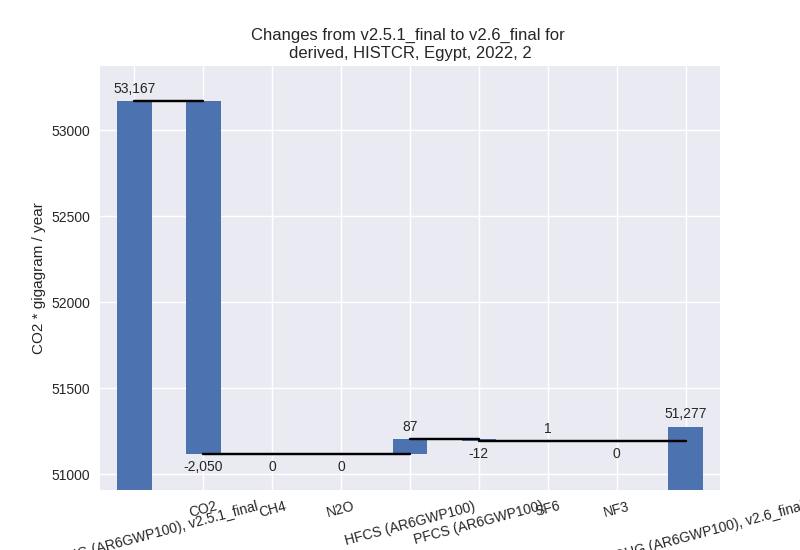
- M.AG: Total sectoral emissions in 2022 are 38790.31 Gg CO2 / year which is 9.6% of M.0.EL emissions. 2022 Emissions have changed by 0.0% (0.00 Gg CO2 / year). 1990-2022 Emissions have changed by 0.0% (0.00 Gg CO2 / year).
- 4: Total sectoral emissions in 2022 are 40024.20 Gg CO2 / year which is 9.9% of M.0.EL emissions. 2022 Emissions have changed by 1.7% (668.33 Gg CO2 / year). 1990-2022 Emissions have changed by 0.4% (93.23 Gg CO2 / year).
- 5: Total sectoral emissions in 2022 are 1447.73 Gg
CO2 / year which is 0.4% of M.0.EL emissions. 2022 Emissions have
changed by 16.1% (201.29 Gg CO2 /
year). 1990-2022 Emissions have changed by 18.0% (136.67 Gg CO2 / year). For 2022 the
changes per gas
are:
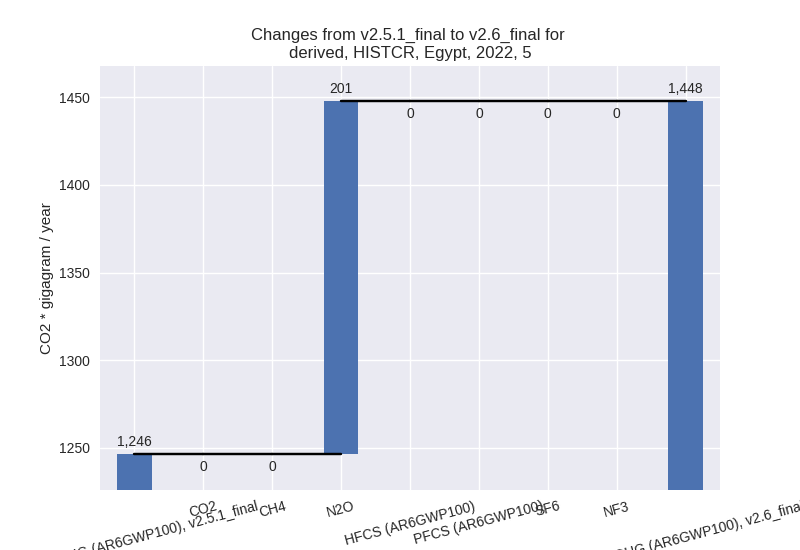
For 1990-2022 the changes per gas are: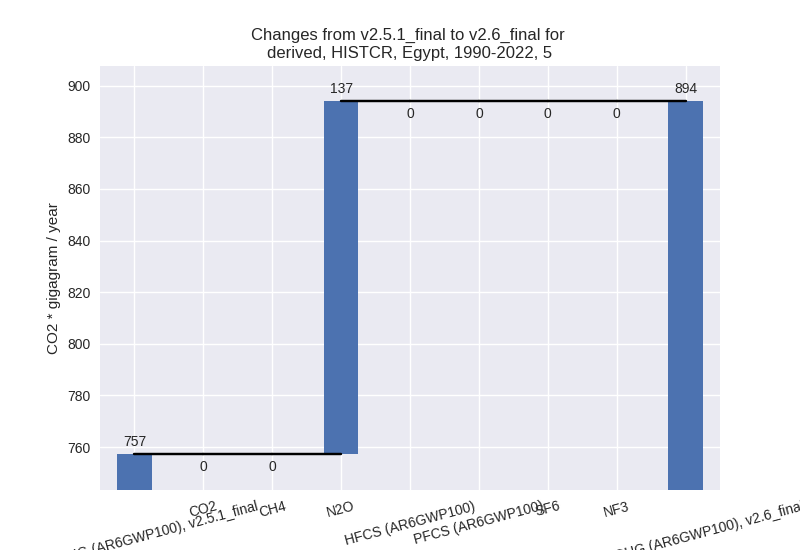
third party scenario (HISTTP):
Most important changes per time frame
For 2022 the following sector-gas combinations have the highest absolute impact on national total KyotoGHG (AR6GWP100) emissions in 2022 (top 5):
- 1: 1.A, CO2 with 17193.49 Gg CO2 / year (7.2%)
- 2: 2, CO2 with -2020.00 Gg CO2 / year (-5.9%)
- 3: 4, CH4 with 680.94 Gg CO2 / year (3.2%)
- 4: 2, HFCS (AR6GWP100) with 230.36 Gg CO2 / year (1.5%)
- 5: 5, N2O with 201.29 Gg CO2 / year (16.1%)
For 1990-2022 the following sector-gas combinations have the highest absolute impact on national total KyotoGHG (AR6GWP100) emissions in 1990-2022 (top 5):
- 1: 1.A, CO2 with 1061.07 Gg CO2 / year (0.7%)
- 2: 4, CH4 with 257.08 Gg CO2 / year (1.6%)
- 3: 5, N2O with 136.67 Gg CO2 / year (18.0%)
- 4: 4, N2O with 134.59 Gg CO2 / year (10.2%)
- 5: 2, CO2 with -61.21 Gg CO2 / year (-0.3%)
Changes in the main sectors for aggregate KyotoGHG (AR6GWP100) are
- 1: Total sectoral emissions in 2022 are 299893.53
Gg CO2 / year which is 73.7% of M.0.EL emissions. 2022 Emissions have
changed by 6.1% (17214.76 Gg CO2 /
year). 1990-2022 Emissions have changed by 0.6% (1050.16 Gg CO2 / year). For 2022 the
changes per gas
are:
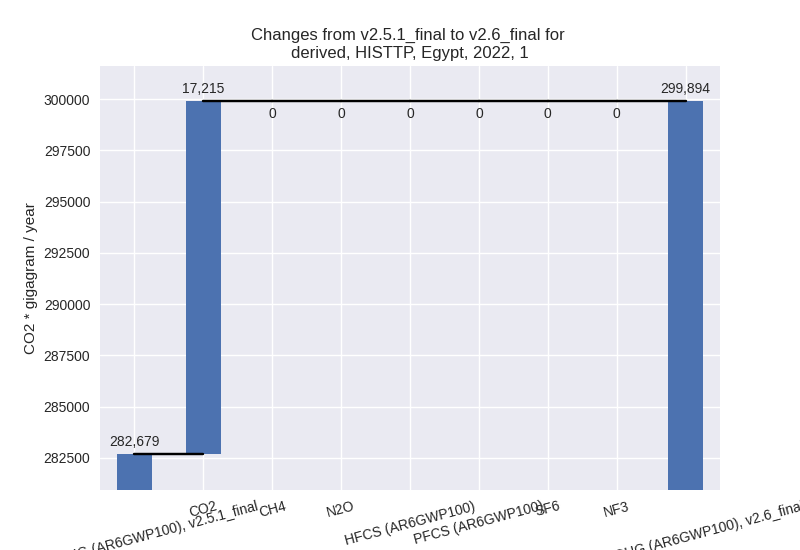
The changes come from the following subsectors:- 1.A: Total sectoral emissions in 2022 are 257607.96
Gg CO2 / year which is 85.9% of category 1 emissions. 2022 Emissions
have changed by 7.2% (17193.49 Gg
CO2 / year). 1990-2022 Emissions have changed by 0.7% (1061.07 Gg CO2 / year). For 2022 the
changes per gas
are:
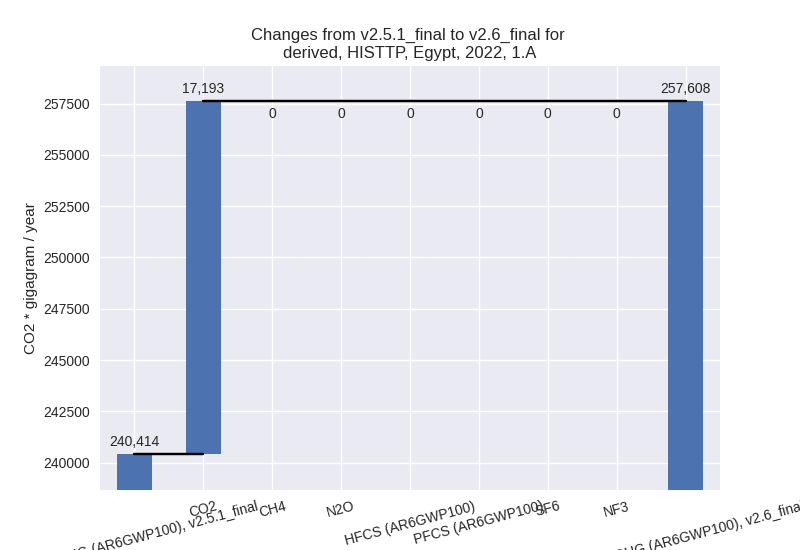
There is no subsector information available in PRIMAP-hist. - 1.B.1: Total sectoral emissions in 2022 are 4019.48 Gg CO2 / year which is 1.3% of category 1 emissions. 2022 Emissions have changed by 0.0% (0.00 Gg CO2 / year). 1990-2022 Emissions have changed by 0.0% (0.00 Gg CO2 / year).
- 1.B.2: Total sectoral emissions in 2022 are 38266.09 Gg CO2 / year which is 12.8% of category 1 emissions. 2022 Emissions have changed by 0.1% (21.28 Gg CO2 / year). 1990-2022 Emissions have changed by -0.0% (-10.91 Gg CO2 / year).
- 1.A: Total sectoral emissions in 2022 are 257607.96
Gg CO2 / year which is 85.9% of category 1 emissions. 2022 Emissions
have changed by 7.2% (17193.49 Gg
CO2 / year). 1990-2022 Emissions have changed by 0.7% (1061.07 Gg CO2 / year). For 2022 the
changes per gas
are:
- 2: Total sectoral emissions in 2022 are 55949.60 Gg
CO2 / year which is 13.8% of M.0.EL emissions. 2022 Emissions have
changed by -3.0% (-1716.41 Gg CO2 /
year). 1990-2022 Emissions have changed by -0.0% (-4.21 Gg CO2 / year). For 2022 the
changes per gas
are:
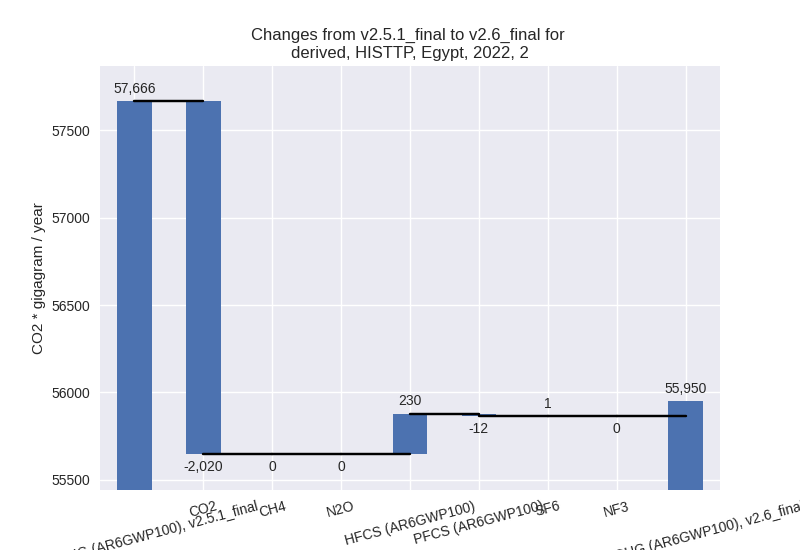
- M.AG: Total sectoral emissions in 2022 are 25405.27 Gg CO2 / year which is 6.2% of M.0.EL emissions. 2022 Emissions have changed by 0.0% (0.00 Gg CO2 / year). 1990-2022 Emissions have changed by 0.0% (0.00 Gg CO2 / year).
- 4: Total sectoral emissions in 2022 are 24179.67 Gg
CO2 / year which is 5.9% of M.0.EL emissions. 2022 Emissions have
changed by 3.6% (837.19 Gg CO2 /
year). 1990-2022 Emissions have changed by 2.3% (391.66 Gg CO2 / year). For 2022 the
changes per gas
are:
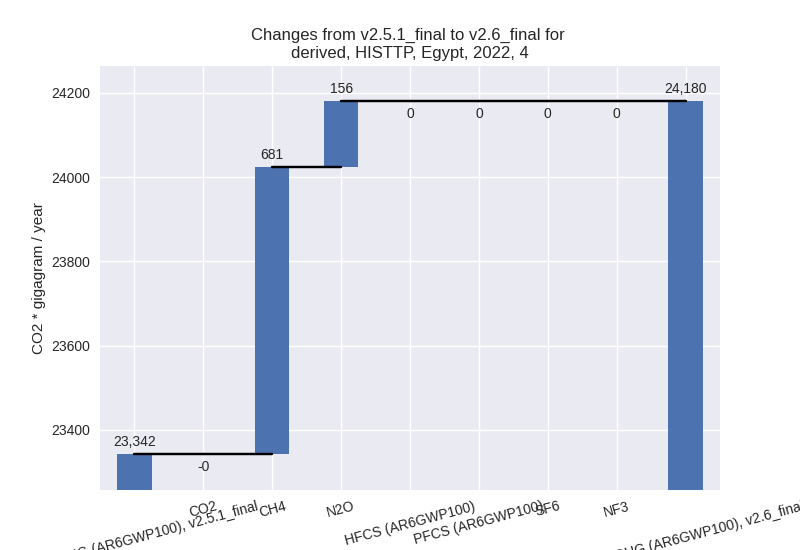
For 1990-2022 the changes per gas are: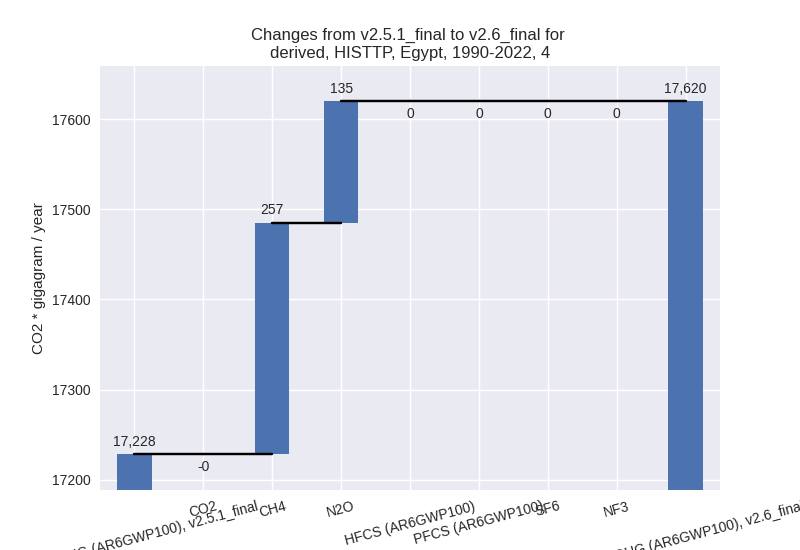
- 5: Total sectoral emissions in 2022 are 1447.73 Gg
CO2 / year which is 0.4% of M.0.EL emissions. 2022 Emissions have
changed by 16.1% (201.29 Gg CO2 /
year). 1990-2022 Emissions have changed by 18.0% (136.67 Gg CO2 / year). For 2022 the
changes per gas
are:
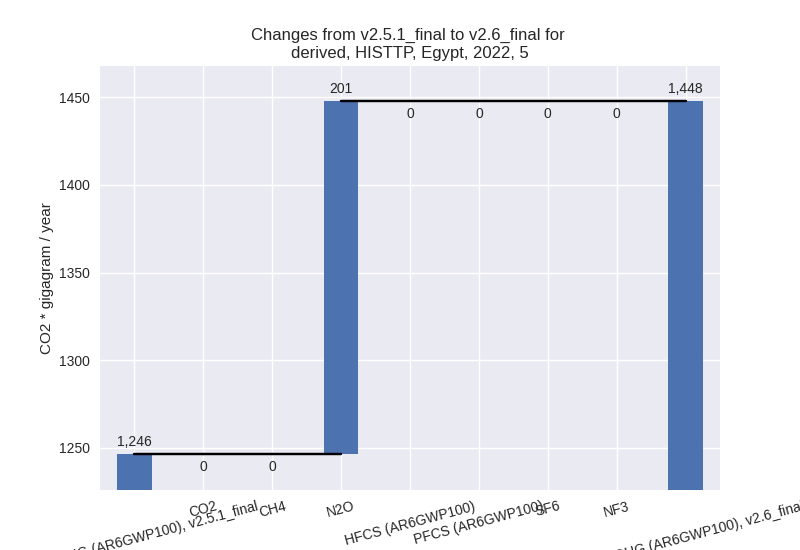
For 1990-2022 the changes per gas are: